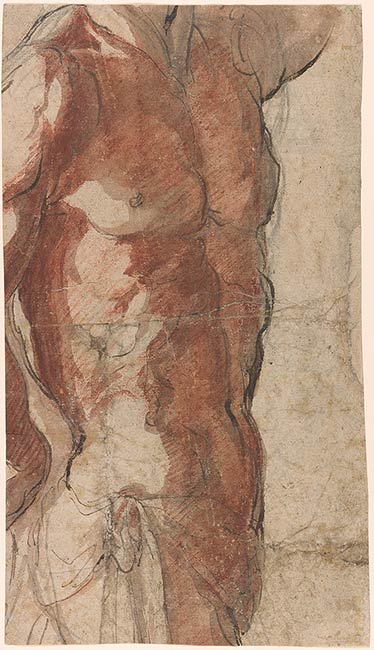

The sheet was cut down when the verso was considered the primary drawing. The old inscription, Polidoro, on the verso is believed to refer to the Venetian painter Polidoro da Lanciano.1 The torso study was first ascribed to Parmigianino by Philip Pouncey (note recorded in the curatorial file, 1958). It was not, however, included in A. E. Popham’s catalog of Parmigianino’s drawings or David Ekserdjian’s subsequent supplement.2 Achim Gnann, on the other hand, accepts the recto as by Parmigianino, suggesting that it may prepare the rightmost figure (Joseph of Arimathea?) in one of the artist’s two etchings of the Entombment.3
Footnotes:
- Washington and New York 1973-74, 71, no. 59.
- Popham 1971; Ekserdjian 1999.
- The Illustrated Bartsch, 16: 9, no. 6; Gnann 2007, 1: 388-89, no. 242.
Watermark: none.
Inscribed on verso, at lower left, in pen and brown ink, "Polidoro".
Polidoro, da Lanciano, -1565, Formerly attributed to.
Moscardo family, former owner.
Calceolari, marquis de, former owner.
Piancastelli, Giovanni, 1845-1926, former owner.
Brandegee, Edward, former owner.
Brandegee, Mary, former owner.
Scholz, János, former owner.
Selected references: Notre Dame 1964, no. 30; Notre Dame 1967, no. 21; Washington and New York 1973-74, 71, no. 59; Gnann 2007, 1: 387-88, no. 242.
Oberhuber, Konrad, and Dean Walker. Sixteenth Century Italian Drawings From the Collection of János Scholz. Washington, D.C. : National Gallery of Art ; New York : Pierpont Morgan Library, 1973, no. 59, repr.
